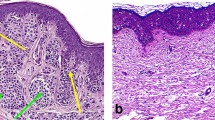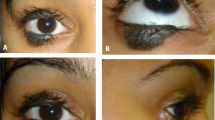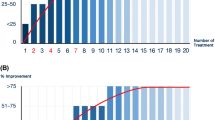Abstract
Background
A congenital divided nevus, also known as kissing nevus, is a type of congenital compound nevus that affects equal areas of the upper and lower eyelids. The edges of the nevus touch or “kiss” during closure of the lids, owing to its extension to the lid margins. Multiple treatment modalities, such as dermabrasion, cryotherapy, primary closure after excision, and skin grafts, have been proposed; however, complications such as recurrence, ectropion, skin color mismatch, and scar contractures are known to occur. This study aimed to introduce a staged excision using the 10,600-nm CO2 pulsed laser to remove a congenital divided nevus without noticeable complications.
Materials and Methods
From August 2015 to December 2018, patients with congenital divided nevus underwent staged laser excision. Seven patients underwent staged mosaic pattern punch excision with a laser. Eight patients underwent concomitant excision, and one patient underwent skin grafting of the medial canthus. Patient satisfaction was assessed immediately and at 3 months after the procedure.
Results
During the study period, 15 patients (10 women and 5 men), with a mean age of 26.0 years (range 13–73 years), underwent laser excision. Continuity of the eyelid margins was maintained in 13 patients. In one patient, the eyelashes grew inward and developed inflammation. No patient developed complications during the healing process, except for partial loss of cilia. Eleven patients were very satisfied, whereas three were satisfied with the results. One patient discontinued treatment after two laser sessions.
Conclusion
We performed multiple staged mosaic punching excisions of a congenital divided nevus with the CO2 laser in 15 cases. We observed consistent therapeutic results without definite recurrence, while maintaining the continuity of the eyelid and eyelash.
Level of Evidence IV
This journal requires that authors assign a level of evidence to each article. For a full description of these Evidence-Based Medicine ratings, please refer to the Table of Contents or the online Instructions to Authors www.springer.com/00266.



Similar content being viewed by others
References
Desai SC, Walen S, Holds JB, Branham G (2013) Divided nevus of the eyelid: review of embryology, pathology and treatment. Am J Otolaryngol 34(3):223–229
Margulis A, Adler N, Bauer BS (2009) Congenital melanocytic nevi of the eyelids and periorbital region. Plast Reconstr Surg 124(4):1273–1283
Jia R, Zhu H, Lin M et al (2012) Clinicopathological characteristics and surgical outcomes of divided nevus of the eyelids: a decade’s experience on 73 cases. Ann Plast Surg 68(2):166–170
Lim SA, Ryu AY, Lee DL, Yoon YI (2012) Treatment of congenital divided nevus of the eyelid with excision and blepharoplasty. Arch Plast Surg 39(4):437–439
Zeng Y (2014) Divided nevus of the eyelid: successful treatment with CO2 laser. J Dermatol Treat 25(4):358–359
Ozaki M, Suga H, Eto H et al (2014) Efficacy of serial excisions of melanocytic nevi on the face using a carbon dioxide laser: a cosmetic point of view. Aesthetic Plast Surg 38(2):316–321
Fitzpatrick RE, Tope WD, Goldman MP, Satur NM (1996) Pulsed carbon dioxide laser, trichloroacetic acid, Baker–Gordon phenol, and dermabrasion: a comparative clinical and histologic study of cutaneous resurfacing in a porcine model. Arch Dermatol 132(4):469–471
Author information
Authors and Affiliations
Corresponding author
Ethics declarations
Conflict of interest
The authors declare that they have no conflict of interest to disclose.
Ethical Approval
The need for informed consent was waived by the institutional review board of the Cheil General Hospital because the study was retrospective. The study conformed to the principles of the Declaration of Helsinki.
Informed Consent
For this type of study, informed consent is not required.
Additional information
Publisher's Note
Springer Nature remains neutral with regard to jurisdictional claims in published maps and institutional affiliations.
Electronic supplementary material
Below is the link to the electronic supplementary material.
Rights and permissions
About this article
Cite this article
Cho, HJ., Lee, W., Jeon, MK. et al. Staged Mosaic Punching Excision of a Kissing Nevus on the Eyelid. Aesth Plast Surg 43, 652–657 (2019). https://doi.org/10.1007/s00266-019-01362-0
Received:
Accepted:
Published:
Issue Date:
DOI: https://doi.org/10.1007/s00266-019-01362-0




